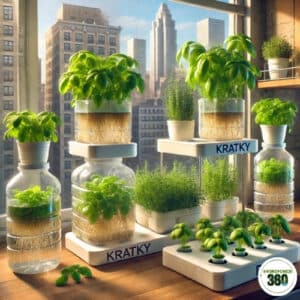Easy DIY Hydroponics for City Dwellers
Table Of Content
Hydroponic gardening has gained a huge following over the last decade. But there’s something about building your own hydroponic system that turns growing plants into something personal. DIY hydroponics isn’t just about saving money or experimenting with tech. It’s about learning how plants work, how systems interact, and how small details make a massive difference.
When I first got into hydroponics, I was fascinated by store-bought systems. But the more I read and learned, especially through practical resources, the more I realized DIY hydroponics was within reach — even for beginners.
DIY doesn’t mean complicated. It means you control the size, materials, and style. Whether you want to grow herbs on your kitchen counter or lettuce in your garage, DIY hydroponics lets you build exactly what you need.

What Is DIY Hydroponics Exactly?
DIY hydroponics is simply building your own soilless growing system using basic materials — usually common items like buckets, PVC pipes, air pumps, and nutrient solutions. Instead of buying expensive pre-made systems, you design and assemble the system yourself.
Most DIY hydroponic systems follow the same core principle: deliver oxygen, nutrients, and water directly to plant roots, without soil. The beauty of hydroponics is that the systems can be as simple or advanced as you like.
Why People Love DIY Hydroponics
One of the biggest reasons people dive into DIY hydroponics is flexibility. Store-bought systems come in fixed sizes and styles. Building your own system allows you to adjust everything to your needs.
Have a small space? No problem. Want to grow vertically? Totally possible. Working with a tight budget? DIY hydroponics is perfect.
But there’s another reason DIY hydroponics has become so popular — it teaches growers to really understand their plants. When you build the system, you understand why every part exists. Pumps, timers, tubing, air stones — nothing feels random because you’ve chosen each element.
Most Popular DIY Hydroponic Systems To Build
There’s no single way to build a hydroponic system. But some designs have stood the test of time because they’re simple, reliable, and beginner-friendly.
The Kratky Method
The Kratky method might be the simplest form of DIY hydroponics. No pumps, no electricity — just a plant sitting in a net cup suspended over a nutrient solution. As the plant grows and uses water, roots stretch deeper into the reservoir, pulling oxygen naturally.
It’s a perfect first project for beginners.
Deep Water Culture (DWC)
DWC systems use a bucket or reservoir filled with nutrient solution. Plants sit in net cups above the water, while air stones connected to a pump supply oxygen to the roots. It’s a great choice for leafy greens or herbs.
Nutrient Film Technique (NFT)
NFT systems involve a thin stream of nutrient solution flowing over plant roots inside a sloped channel. The system continuously recycles water, making it efficient and space-saving.
Building an NFT system requires more planning but offers excellent results, especially for fast-growing plants like lettuce.
Ebb and Flow
This design floods the plant roots with nutrient solution at set intervals, then drains the water back into a reservoir. It’s a little more complex but great for growers who want automation.
Essential Components of Any DIY Hydroponics System
Regardless of design, every DIY hydroponic system needs some basic parts:
- A reservoir to hold nutrient solution
- A way to deliver oxygen (air stones or natural airflow)
- Net pots or growing containers
- Growing media like clay pebbles or coco coir
- Tubing and pumps (for more active systems)
- A reliable nutrient solution designed for hydroponics
Getting the nutrient solution right is critical. DIY hydroponics is about creativity, but feeding plants correctly requires precision.
Common Mistakes to Avoid When Building DIY Hydroponics
Every grower makes mistakes — that’s part of the DIY spirit. But there are some common errors that can easily be avoided with good preparation.
One of the biggest mistakes I see is not providing enough oxygen to plant roots. Hydroponic plants need constant access to both water and air. Skipping the air pump or misplacing air stones can lead to root rot fast.
Another classic beginner error is using the wrong fertilizer. Regular garden fertilizer doesn’t fully dissolve in water and can clog systems or cause nutrient imbalance. Hydroponic-specific fertilizers are essential.
Finally, don’t underestimate system cleanliness. DIY systems need regular cleaning to avoid algae buildup or bacterial growth.
Why DIY Hydroponics Is Perfect for Beginners
DIY hydroponics might sound technical at first, but it’s actually one of the most beginner-friendly ways to start growing plants without soil. You learn by doing. Every part of the system teaches you something — about plants, about water chemistry, about how to create healthy environments.
What I love most is how personal DIY systems feel. They’re built around your space, your goals, and your resources. They evolve over time as your skills grow.
DIY Hydroponics Turns Growing Into Craft
Building your own hydroponic system is about more than growing plants. It’s about curiosity, problem-solving, and personal satisfaction.
In a world where so much feels automated or disposable, there’s something incredibly rewarding about crafting your own system from basic materials and watching it work.
If you’re new to hydroponics, starting with DIY systems is not just a budget-friendly option — it’s a smart one.
DIY hydroponics isn’t just about saving money — it’s about building confidence, skill, and a deeper connection to how plants grow.
FAQs
Is DIY hydroponics hard to build?
Not at all. Simple systems like the Kratky method require almost no technical skill, while other designs like DWC can be built using basic tools.
Can I use regular fertilizer in DIY hydroponics?
No, hydroponics requires specific fertilizers that fully dissolve in water and provide balanced nutrients.
What is the cheapest DIY hydroponic system?
The Kratky method is usually the cheapest since it doesn’t require pumps or electricity.
Table Of Content
